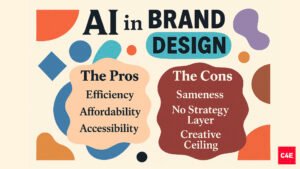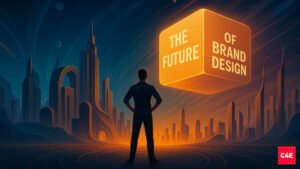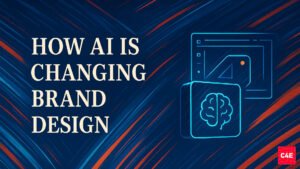Is AI Taking Over Brand Design? Everything You Need to Know
You can spot it from a mile away: that too-perfect symmetry, the color palette straight out of a preset.
Another logo, another brand that looks like it was made by a bot.
Because it was.
AI in brand design is already here, and it’s moving faster than most brands can think.
Tools like Looka can churn out a brand kit before you finish your coffee. MidJourney can turn your prompts into moodboards that could pass for a full visual identity.
It’s efficient.
It’s impressive.
It’s also a little terrifying.
Because with every shortcut, there’s something you’re cutting.
Originality. Intent. The part that makes a brand feel like more than mere pixels on a screen.
Still, it’s not a villain story. AI isn’t here to destroy design, only to challenge it.
This piece is your cheat sheet: what’s changing, what’s at risk, which tools matter, and how to adapt without losing what makes your work worth doing.
All ready to begin? Let’s build the future.
What AI Is Already Doing in Brand Design
Designing used to start with a blank page. Now, it starts with a prompt.
Today’s AI branding tools can generate. Logos, color palettes, font pairings, mockups, even full-blown brand kits. All in minutes. All without a designer in the room.
Take Looka, for example. Type in a brand name, pick a few styles, and you’ve got a logo, typography suggestions, business card layouts, and social media banners. Bundled and ready to go.
Need visuals to match? Plug a few keywords into MidJourney, and you’ve got surreal, scroll-stopping brand imagery before your art director has even opened Figma.
And it’s not niche anymore.
88% of digital marketers already use AI in their day-to-day tasks. From content to design, automation is becoming the default.
For early-stage startups and solopreneurs, this is a dream come true. Speed without the spend. A fast track to market-ready.
But for seasoned designers, it raises a different question: If AI can do the visual heavy lifting, what’s left?
That’s the tension we want to unpack here.
Pros and Cons: Speed vs. Soul

Let’s get the obvious out of the way: AI makes brand design fast.
What used to take days now takes minutes.
Want revisions? Instantly.
Looking for some variations? The options are endless.
Need a logo in five styles? Done.
Need it resized for every platform? Already exported.
This is where AI in brand design shines: speed, scale, accessibility.
But just because something is easy to make doesn’t mean it’s worth remembering.
The Upside
- Efficiency: Design at the speed of thought. Iterate, test, and tweak without starting over.
- Affordability: A full brand kit for the price of a coffee. For MVPs, that’s a game-changer.
- Accessibility: No designer? No problem. AI levels the field for founders, freelancers, and side hustlers.
93% of marketers use AI to generate content faster, and 81% say it helps find insights that shape smarter decisions.
The Downside
- Sameness: When everyone uses the same tools, brands start to blur. What’s fast becomes forgettable.
- No Strategy Layer: AI can pick colors. It can’t define positioning. Your brand needs more than aesthetics.
- Creative Ceiling: The more you rely on AI output, the less original the input becomes. It’s a loop. And loops get stale.
So yes, AI can make you look good fast. But it can’t make you matter.
Not unless you bring something to the table that no tool can replicate: your perspective, your story, your weird, wonderful, irreplaceable human edge.
How Designers Can Adapt
AI won’t replace designers, but it likely will replace designers who refuse to adapt.
Because the ones who win are the ones doing what AI can’t.
Use AI as a Starting Point, Not the Final Say
Treat AI tools the way you’d treat a moodboard or a rough draft: as a springboard and not the solution. Let them spark ideas.
Your job is to decide what’s worth keeping and what still needs soul.
Understand What AI Can’t Do
The best designers won’t compete with AI on speed but double down on what machines still can’t replicate:
- Brand storytelling that feels lived-in, not lifted from templates
- Cultural nuance, emotional intelligence, aesthetic intuition
- Strategy-first design decisions that align with real-world goals
83% of marketers say AI frees up time for more strategic, creative work. That’s the space you should be claiming.
Get Good at Creative Direction
When anyone can generate, the real value is in curating. Knowing what aligns with a brand’s voice, what stands out in a sea of sameness, and what resonates long after the scroll stops.
Because AI doesn’t lower the bar, it only raises expectations.
And if you’re still designing like it’s 2015, you’re bound to be invisible.
The Future of Brand Design

The future isn’t AI. The future isn’t humans. It’s both.
Call it co-creation, hybrid workflows, or just smart design, but the next wave of branding will be built by humans who know how to work with machines, not against them.
AI will handle the heavy lifting: iterations, mockups, format resizing, visual exploration.
Designers will do the meaning-making: positioning, emotional tone, cultural fit.
And that’s not speculative. Companies using AI across marketing are already shifting 75% of their staff’s time from production to strategy. The design world is headed the same way.
What’s Coming Next
- Hyper-personalization: Real-time brand assets that adapt by audience or context
- Creative orchestration: Designers as conductors of multi-tool, multi-channel brand systems
- Ethical design checks: Humans as the gatekeepers for bias, tone, and representation in AI outputs
But design won’t be judged anymore just by how it looks. It’ll be judged by how fast it adapts, how well it speaks to consumers, and how little time it took to get there.
This is less the death of branding and more a reset.
The brands that survive will look different because they’ll think differently.
Your Brand’s Future Starts with How You Adapt
AI isn’t the threat. Complacency is.
AI in brand design is already reshaping how we build, scale, and share identities. The tools are out there. The speed is unmatched. The possibilities are endless.
But what still matters and always will is:
- The why behind the design.
- The strategy behind the style.
- The human behind the brand.
Only 1% of businesses that have invested in generative AI have recovered their full investment.
That’s not because the tools don’t work, but it’s because tools don’t think. People do.
If you’re a designer, this isn’t the time to panic. It’s the time to pivot, to direct instead of produce, to lead instead of follow.
To use AI and not be used by it.
The future of brand design is augmented, and the best designers will be the ones who know how to build with both hands: one human, one machine.


